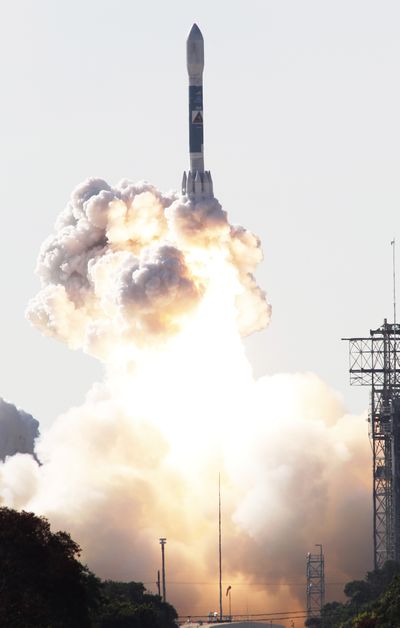GRAIL mission to moon launches
Twin orbiters aim to map lunar gravitational field

CAPE CANAVERAL, Fla. – Shaking off a two-day delay that began with swirling winds on the coast of Florida, NASA launched its GRAIL mission to the moon Saturday, seeking a greater understanding of Earth’s nearest neighbor through a promising dual-spacecraft technology.
The Delta II rocket carrying the paired washing-machine-size craft that make up the Gravity Recovery and Interior Laboratory lifted off into a blue sky from Cape Canaveral, Fla., at 9:08 a.m. EDT.
Roughly 90 minutes later, NASA confirmed that GRAIL-A and GRAIL-B had separated from the rocket, unfurled their solar panels and begun a three-and-a-half-month trip to the moon.
“Our GRAIL twins have Earth in their rear-view mirrors,” said David Lehman, GRAIL project manager at the Jet Propulsion Laboratory in La Canada Flintridge, Calif., which is managing the $496 million mission.
Maria Zuber, professor of geophysics at the Massachusetts Institute of Technology and GRAIL’s principal investigator, said in an email that the launch, long in the making, was an emotional experience. It was akin, she said, to watching a child practice for years at music or sports, “then watching them perform in extraordinary fashion.”
NASA had scrubbed planned launches Thursday and Friday, first as a result of foul weather and then because of a data glitch.
The spacecraft will spend three months making 12 polar orbits of the moon each day. Scientists predict that the mission will provide a map of the lunar gravitational field, data that will allow for the first comprehensive assessment of the moon’s crust, mantle and core.
Considering that 12 humans have walked on its surface, there are still surprisingly significant questions about the moon. For instance, scientists do not know why lava flooded the plains on one face of the moon but does not appear to have reached the surface elsewhere. Understanding the moon’s thermal history would add to the understanding of the evolution of the rocky planets, including Earth.
The study of the moon has been hamstrung by a quirk of the solar system: Because the moon happens to spin at the same rate that it orbits Earth, only half of the moon is visible to us. A single spacecraft studying the moon can send back data only when it has a direct line of communication to Earth, which can only happen on the side of the moon facing us, or the near side.
GRAIL marks the first time that a technique known as “precision formation flying” – studying the same object using multiple, coordinated spacecraft – will be used beyond Earth’s orbit.
Two spacecraft will fly in locked formation and will speak to each other through a high-frequency signal rather than to scientists on Earth. As they orbit together, even minute changes in gravity will change the distance between the craft – allowing for the first true “map” of the moon’s gravitational field, even on the far side of the moon.
Scientists predict enormous leaps in their understanding of the moon – even the resolution of a dispute over whether Earth once had two moons, which collided and fused together.